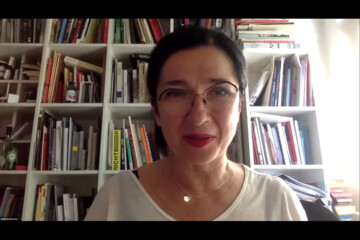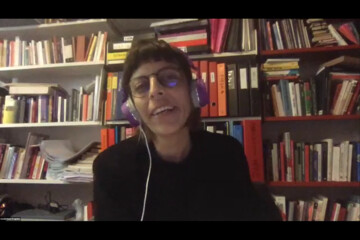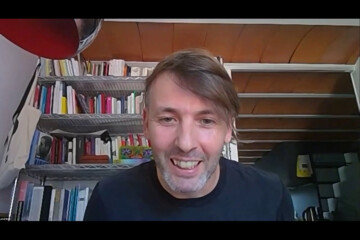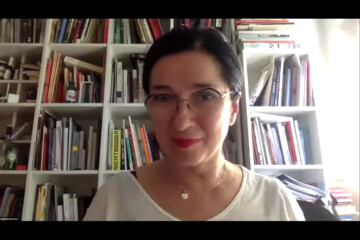Unconditional Care and Solidarity
Today, in the midst of a pandemic, “→ care” (→ care) has become a keyword, one that also comes up often in current discussions and projects in the international art world. Very few of these discussions, however, note that the kind of care we are talking about, which today is largely the province of specific community and civil-society initiatives, was once deeply integrated into certain countries’ social systems, or that it would be wise to reinstate a place for care, and to do so more strongly, in larger systems. By larger systems I mean not only individual countries, but also international initiatives that could successfully oppose global homogenisation by, among other things, relying on the work of the micropolitical structures that already exist today. We need systems of interdependence[1], in which larger entities acknowledge their dependence on smaller entities and incorporate it in the way they function. Now, in light of the current pandemic, our interdependence is all the more evident, and it is plainer than ever that it cannot be based solely on human-to-human relationships but must also include non-human agencies. The virus that first appeared in a market in Wuhan proves that globalism is dependent even on micro-locations and micro-events. The pandemic, indeed, has made us more aware of the interdependence that exists on our planet, but we can extend this interdependence to the cosmos, whose processes influence our lives and where we, too, are leaving our mark. And if the tiny coronavirus remains a riddle for us, what can we say about the whole of creation, in which humanity is merely an episode in the eternal processes of genesis and decline? Interdependence is not merely what we imagine it to be, nor is it in any way the expression of our symbolic order; rather, it includes secrecy within itself.
The pandemic has not only made us more aware of universal interdependence, but has also sparked a further radicalisation of protectionism and nationalism, and it is very possible that we will soon be facing new geopolitical conflicts. A number of Slovenia’s progressive business leaders and intellectuals, who recently joined together in the initiative “Ordinary People and Citizens” (Sleherniki in civilisti), warn us of a possible end to multilateralism and the curtailment of certain international institutions, such as the World Trade Organization, the United Nations, the World Health Organization, the World Bank, and the International Monetary Fund. Many of us might say, so what if these institutions are curtailed – they should be serving the cause of international cooperation and → solidarity but have instead become subservient to the interests of capital and to states and corporations competing for global economic dominance. While we will of course still need such international institutions, it is clear they will have to function differently and be rooted in that interdependence which is becoming ever more obvious and ever more critical. New systems of interdependence can only be based on international solidarity and a new approach to public resources and care for the environment. Globalism is built not on the world we all share, but on the privatisation of the world; it is not interested in international solidarity, but in the accumulation of power and capital and the distribution of knowledge and information that is subject to this. The idea of a shared world can be built only on a different kind of internationalism, which includes international solidarity, by which I mean it respects the needs of individual groups and localities and their right to survival and to equal participation in the global exchange of ideas and goods – their right to participate in the creation of the commons. The commons means not only shared natural resources, but also shared social conditions for widespread participation in the formation of the world we share.
The imaginary of contemporary art reflects both our dependences and our interdependence, thus tracking two forces that are bigger than us as individuals: a force that dominates us almost completely and turns us into passive objects, and a force that draws us towards active cooperation and collaboration. The central question in Alberto Toscano and Jeff Kinkle’s book Cartographies of the Absolute is how to depict the all-powerful force of capitalism. Here they see “an aesthetic problem, in the sense of demanding ways of representing the complex and dynamic relations intervening between the domains of production, consumption and distribution, and their strategic political mediations, ways of making the invisible visible.”[2] Of course, this is also a kind of interdependence, but it is one based on mutual interest and profit, whereas what we are envisioning is the interdependence of society not as individuals but as a community based on unconditional solidarity, which is a necessary condition for the survival of all.
Art has always been committed to something larger than the individual artist, whether this is some unknown, ungraspable force or the idea of community in all its possible scope. While dependence on some unknown, ungraspable force has often, in the history of art, been depicted in terms of wild nature, the “sublime” in today’s art may be shown in graphs and photographs, videos depicting the distribution and consumption of goods, or sculptures made from modern-day materials. Interdependence, meanwhile, is represented through some sort of active engagement of people, animals, or even inanimate things, striving for universal rights.
The pandemic has thrust to the forefront questions of interdependence and the universal rights associated with it, including, for instance, the right to health care, the right to work, the right to housing, and even the right to the city.
The Right to Housing
One of the key messages during lockdown – “Stay home” – although full of concern for the health of the general public, does not include the many people who have no home in which to stay. Throughout the refugee crisis of the past few years, the Balkans have been one of the main routes for migrants coming to Europe, but it is a route fraught with obstacles. For a long time now there have been reports from Bosnia about the dire situation of refugees, although, since lockdown began they have been arriving in fewer numbers. Right before the pandemic was officially declared, the artist Jošt Franko created a collage of photographs of refugee homes, which he titled AFGHANISTAN TUZLA Good, February 8th, 2020. He accompanied it with the following text:
The last passenger train deposited the arrivals at the central station in Tuzla two months ago. Now only boxcars with coal from the Banovići mines travel the rails to the Tuzla thermal power plant. The overcrowded temporary reception centres in Bihać and Kladuša are no longer taking in new refugees. The authorities are systematically detaining migrants in other parts of the Federation. Public transport is monitored and refugees are prevented from continuing on their road to the EU. The authorities of the Tuzla Canton have decided not to set up temporary reception centres under the auspices of the International Organisation for Migration. Hundreds of people sleep on railroad platforms every night. Local NGOs have organised overnight accommodation for families and vulnerable groups.

Jošt Franko, AFGHANISTAN TUZLA Good, 2020, photo collage, 200 x 55 cm. Courtesy of the artist.
With the onset of the coronavirus crisis, the issue of the refugees receded into the background and priority was given to people with street addresses. In no way do I wish to imply that residents do not deserve whatever care they receive; quite the contrary, the pandemic has shown us yet again that we must do a better job of connecting different issues – the pandemic, the refugee crisis, the economy, and the environment. Civil initiatives have an important role to play in addressing crisis situations, which they also attempt to do through the participation of those who are most affected. The slogan “Stay home” also leaves out many who, even if they have citizenship papers, are still unable to find affordable housing; in their case, civil initiatives that work for changes in local housing policies are all the more welcome.
One such initiative is an action by the Slovene Housing for All Network (Mreža stanovanje za vse), which was launched long before the pandemic; it brings together architects, urban planners, sociologists, legal experts, NGOs, and students in an organised effort to influence public opinion and put pressure on policymakers to address the issue in a systemic and sustainable way. The goal is to change Slovenia’s housing legislation through various kinds of pressure and persuasion, which are aimed not only at lawmakers but also, by raising awareness of housing as a basic human right, at all members of society. In our critical discussions of neoliberalism, we too often fail to speak about the crisis in values – the fact that people have lost a sense of what rightfully belongs to them and are, sometimes willfully, unaware of universal rights. This simply means that people have accepted privatisation as part of the “natural” order, where the weaker have lost the battle in competition with the stronger.
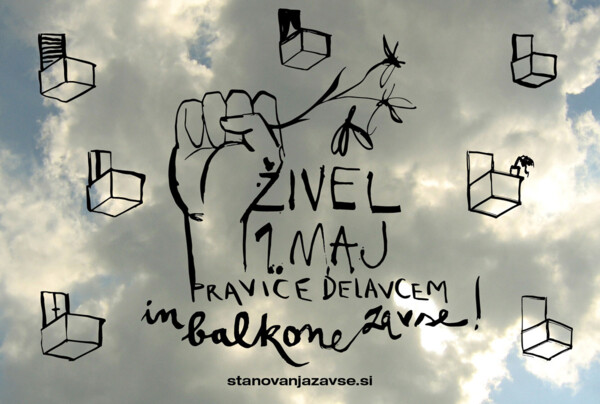
Maja Hawlina, Maša Hawlina, Sara Jassim, May Day Greeting Card from the Housing for All Network [Mreža Stanovanja za vse], 2020. The text addressed to all Slovene governmental institutions, ministries, mayors and municipalities, urbanists, architectural associations, national, and local media, reads: “Long Live the First of May! Rights for Workers and Balconies for All!”
The Right to the City
Along with the right to housing, it is also important to mention the right to the city, which is threatened, on the one hand, by the pandemic and the understandable safety measures put in place to stop the spread of the virus, and, on the other, by the way certain national leaders are exploiting the situation as an ideal opportunity to realise their strong-arm tendencies. The current economic, social, environmental, and health crises, along with growing nationalism and institutionalised racism, are triggering ever more protests and demonstrations throughout the world, which the authorities try to suppress by barricading streets and squares, limiting movement, and expanding digital surveillance. In some countries, the ruling powers are exploiting this time of mass isolation to do things that, under normal conditions, would provoke even greater resistance within the population.
Recently, the international art world was abuzz with the story about how the authorities in Tirana had used the time of the pandemic to demolish the historic Albanian National Theatre in the heart of the city. In the early 2000s, then-mayor Edi Rama, who today is the nation’s prime minister, became a symbol of contemporary Albania when he ordered that the never-replastered buildings of the once grey socialist city be painted in bright colours – blue, green, orange, purple, yellow, and red. Several curators later got involved with this monumental action and invited a number of internationally established artists, such as Olafur Eliasson, Liam Gillick, and Dominique Gonzalez-Foerster, to paint other buildings in the city. Tirana thus became a global attraction. Rama was proclaimed the world’s best mayor and, a few years ago, even appeared as an artist at the Venice Biennale. In 2003, the now-established Albanian artist Anri Sala documented the painted façades of Tirana in the film Dammi i Colori (Give me the Colours), which later that year was included in Hans Ulrich Obrist’s exhibition “Utopia Station” at the 50th Venice Biennale. Other Albanian artists also responded to Rama’s colourful façades in 2003, engaging in a public dialogue with their city’s new image. Alban Hajdinaj created a film in which he underscored his position as a local spectator who sees the fresh-painted façades as something alien. Gentian Shkurti, meanwhile, told the story of a colour-blind man who continued to see these buildings as grey – a metaphor for the country’s internal problems, which cannot be painted over by some colourful intervention.
As Albania’s prime minister, Rama has not stopped making artistic interventions and continues to invite internationally known artists and architects to help modernise Tirana, even if this means construction on the site of historic buildings that have helped shape the city’s character. The national theatre was the most recent such building to be demolished in the name of modernisation. A prime example of Italian modernist architecture in the city centre, it was built on Mussolini’s orders during Italy’s occupation of Albania (1939–43). The modernism of the fascist era was later nicely complemented by the socialist modernism of the dictator Enver Hoxha, which today is succeeded by the new architectural style of the global world. Fascism, socialism, and today’s global (post)modernism all share the fact that they elevate their own international language above the local particularities – although not above particular political and ideological interests, which in one way or another always leave their mark. The historic building of the Albanian National Theatre will soon be replaced by a new theatre, which, however, will be part of a larger complex with a shopping mall and a business centre. For the past two years, the planned demolition of the old theatre has been met with protests from theatre performers and other artists, as well as members of the left-wing party Organizata Politike, while the right-wing opposition, led by Monika Kryemadhi, the wife of the Albanian president, has exploited the protests for its own ends. One of the theatre’s last productions was directed by the Croatian Ivica Buljan, who deliberately chose Shakespeare’s Julius Caesar – about a man who begins his career with big, beautiful ideas but ends up as a corrupt emperor who eventually has to be killed. The play was staged in the swimming pool at the head of the square in front of the theatre. It is worth mentioning that this swimming pool accentuated the building’s division into two wings. Under socialism, one wing housed the classical national theatre (the official theatre of the regime), while the other housed an experimental theatre, which was one of the rare spaces of freedom in those leaden times.
For over twenty years, Tirana’s painted façades and Rama’s other interventions in the city’s architectural and urbanistic heritage have generated public debates that go beyond mere aesthetic issues and delve into questions about spatial politics. The Albanian case speaks to issues about art in relation to people’s right to the city and to its collective memory, which is a condition for reproducing any society. The artistic and civil actions in Tirana are not interested in the uninterrupted development of the national culture, or in its allegedly homogeneous unproblematic core, but rather in memory, which relies on various discontinuities. What is “Albanian” must also include the Italian occupation and its fascist architecture, Hoxhaist modernism, and even globalist-style shopping malls.
In the Balkan region we are currently witnessing many examples of irresponsible treatment of cultural heritage, with 20th century modernism especially coming under attack. The most egregious and grotesque example of the destruction of the modernist heritage of socialism is in Skopje, where Macedonian nationalists have covered buildings from the period of socialist Yugoslavia in pseudo-classical façades; among other things, they want to stress the idea that socialism was a deviation in the historical development of a great European culture.
Europa Nostra, a network of cultural heritage protection groups, has compiled a list of Europe’s seven most endangered cultural heritage sites for 2020, of which no less than five are in former socialist countries, and three are in the Balkans. Of these, the 20th century sites include the Albanian National Theatre, which is now gone, and the Bežigrad Central Stadium in Ljubljana, which was designed by the architect Jože Plečnik.
Nature as a Third Element
During the pandemic, discussions in Ljubljana over the fate of Plečnik’s stadium became more intense. Built in the 1930s and modelled on the amphitheatres of antiquity, the stadium has the status of a monument of national significance. Nevertheless, today the interests of capital have the upper hand in decisions about its fate, just as they did about the theatre in Tirana – and in both cases are opposed to the public interest. With Plečnik’s stadium, this is obvious from the far greater amount of surface area being planned for commercial activity compared to what is intended for sustainable communal use by citizens. The realisation of the current plans for the stadium was halted by complications over the necessary environmental protection documents as well as an initiative by local residents, who would be deprived of certain green spaces by the planned development. Disputes over the stadium’s renovation have dragged on for more than ten years, during which time the stadium has been overgrown with grass. The artist Jože Barši, who sees a particular beauty in this overgrown condition, is proposing that the owners be allowed to build whatever they want around the stadium, so long as they leave the interior of the stadium wild and overgrown, with only minimal restoration. Barši’s art installation includes a photograph of the overgrown stadium and, beside it, a display case with documents from the stadium’s history, one of which is another photograph showing the oath-taking of the Slovene Home Guard, under the command of General Leon Rupnik, on Adolf Hitler’s birthday in 1944. In the photo, the Home Guard is taking an oath, as an auxiliary unit of the Nazi SS, to fight alongside Germany against the communists and their allies. Not long → after the war, Leon Rupnik, a committed anti-communist and anti-Semite, was condemned to death and executed by a firing squad. Last year, more than seven decades later, the Supreme Court of Slovenia annulled the Rupnik verdict and sent the case back to the Ljubljana District Court. Rupnik’s story is just another chapter that reveals the deep divide between the descendants of the left and right in the countries of the former Yugoslavia. The divisions surrounding the renovation of Plečnik’s stadium, meanwhile, reflect a not-so-different antagonism between those who advocate a society of the commons and those who support neoliberal interests. Barši’s proposal turns the stadium into a monument that reminds us that everything is transitory. But here we are not dealing with some romantic notion that leaves the resolution of human problems to nature; no, this is more about recognising as an illusion the idea that people have reality under their control. Of course, if I had written this before the pandemic that last statement would have undoubtedly sounded less convincing, but today we are more ready to acknowledge our dependence on non-human agencies.

Jože Barši, Remembering and Forgetting, 2020, installation view, 22 February 2021 – 11 April 2021, The City Art Gallery Ljubljana. Photo: Photo: Andrej Peunik/Museum and Galleries of Ljubljana.
Non-human Agencies
When we speak about interdependence with non-human agencies, we should not think of efforts to create harmonious relations between humanity and nature based on some sort of essentialist identity. Rather, we should think of an interdependence between constantly changing actors. Under the current conditions, it feels as though we are experiencing ever greater, ever faster transformations of identity, and rapid migrations from one living situation to another due to technology and science as well as ever more rapacious capitalism. But ceaseless transformations and mutations are also part of the processes of nature. The pandemic has demolished our illusion of something we never actually had: a stable natural order. When we think of interdependence, we should think of something that is both good and bad at the same time, something that encompasses both nature and our own production.
Even before the pandemic, the question of artificial intelligence and its dominance in our lives was the focus of broad discussions. The visual researcher Gregor Mobius, in his work Proto-RNA, The First Self-Learning Machine (2018), talks about the fact that we developed, over the long process of evolution, from the first organic molecules, which, in a sense, were “self-learning machines”, to use the contemporary term. People want to see this principle of self-learning in artificial intelligence, too, and to teach machines to teach themselves. Mobius reflects on how children possess an innate ability for self-learning that allows them to quickly absorb information about the world around them, just as the first living organisms learned about the environment in which they found themselves, where they had to discover the path of their own survival. Of all the current hypotheses about the origin of life, the most compelling is the theory that the first living molecules were a primitive version of ribonucleic acid – a “proto-RNA”. If this is true, Mobius says, then all of life, culture, and art originated from this molecule four billion years ago. And so did the coronavirus.
Consequently, it makes no sense to understand art simply as a human product, even less as the product of one living person. Of particular interest in this regard are those artists who draw on ideas from the Russian avant-garde, in art, science, and philosophy. Some, such as Anton Vidokle, Arseny Zhilyaev, and Dragan Živadinov, go back to the ideas of Russian cosmism, which says that the only possible equal and just society is one in which, with the important help of science, → the dead also participate. Here we might also include Jonas Staal, who is best known for such projects as New World Summit (2012–present) and New Unions (2016–present), which strive for an open society of cross-solidarities. Recently, Staal and the lawyer Jan Fermon have filed a lawsuit to compel the legal recognition of Facebook as a resource in the public domain that should be owned and controlled by its users. In Staal’s work, people who lack full citizenship rights have a way to participate, and the same is also true for non-human agencies. Such agencies are part of his project Neo-Constructivist Ammonites (2019), which references the heritage of the Russian constructivists and productivists, who viewed revolutionary objects as “comrades”. Staal points to the revolutionary tradition of Rodchenko, Stepanova, and Popova, who contrasted their “comradely objects” with the alienation and fetishisation of objects. They applied new abstract forms to everyday utilitarian objects, and thus stripped their works of the kind of artistic autonomy that was so integral to 20th century Western abstraction. Stepanova and Popova dedicated themselves to designing clothes, fabrics, dishware, and other ordinary objects, while Rodchenko, a master graphic designer of → propaganda (→ propaganda), also designed the interior of the Workers’ Club (1925).
In his installation Neo-Constructivist Ammonites, Staal combined elements from Russian avant-garde propaganda design with the fossilised shells of ammonites, sixty-six to three hundred million years old; once prevalent in the world’s oceans, these mollusks perished in the fifth mass extinction. Today, at a time some are describing as the sixth mass extinction, humans have assumed the main role in the annihilation of species, which are disappearing at a rate a hundred times faster than they would without us. Staal’s ammonites are set on vertical neo-constructivist objects as portraits, if you will, of our non-human comrades, as if they were spreading the word from their pedestals about their heroic role in history, about how the ammonites, which are found in various layers of the → Earth’s crust, help us to understand, recognise, and distinguish different geological eras. The ammonites, then, are our teachers, who tell us how important it is to stand in solidarity with, and be responsible towards, everything that might soon become a fossil.
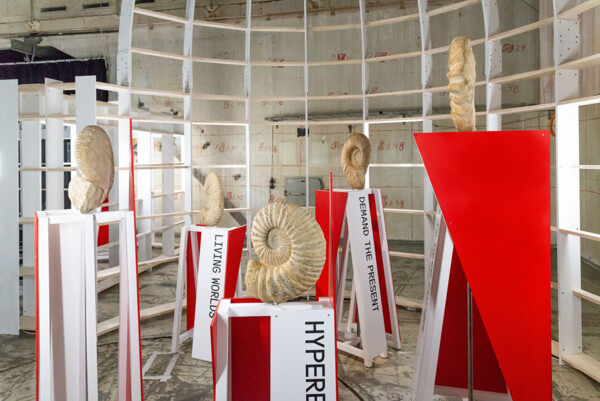
Jonas Staal, Interplanetary Species Society, 2019, Reaktorhallen, Stockholm, produced by the Public Art Agency Sweden. Photo: Jonas Staal.
Secrecy as the Last Universal Right
The interests of capital are destroying not only our cultural heritage but also archaeological sites – even if not always directly. In the recent vast wildfires in Australia, many Aboriginal archaeological sites were destroyed, and more than a billion animals died, including many from species that had been endangered even before the fires, and some of these species are found nowhere else in the world. Moreover, it is clear that the Australian wildfires are the result of climate change.
Through its aesthetic liberation of things, ideas, and layers of time, art constructs imaginaries of interdependence, which in their own way contribute to a society of solidarity. Today, during this time of pandemic, we like to talk about us all being in the same boat, a metaphor that has replaced the catastrophic image of overcrowded boats of refugees crossing the Mediterranean. But the most powerful metaphor of the present time is the metaphor of the virus, which represents how everything influences everyone. However, this is only our view of viruses, our exploitation of their properties. What viruses themselves think about this, nobody knows.
The global circulation of capital, the industrialisation of agriculture, the cultivation and breeding of plant and animal species outside their natural ecosystems – all these things facilitate the development of viruses and their transmission to humans. And now, it seems, viruses are exacting revenge for our irresponsible attitude towards nature. Our attitude towards nature is indeed irresponsible, but viruses have other things to do in life besides teaching us to be wiser. Our relationship with nature is truly interdependent, but as I have noted, it is a dynamic relationship in which all the participants are in fact foreign to each other. We humans must do more to respect this foreignness instead of trying to domesticate something that we can never fully know. Sometimes things must be left unlabeled, without names, and thus also without commercial value. Secrecy may be the last universal right we must still preserve.

